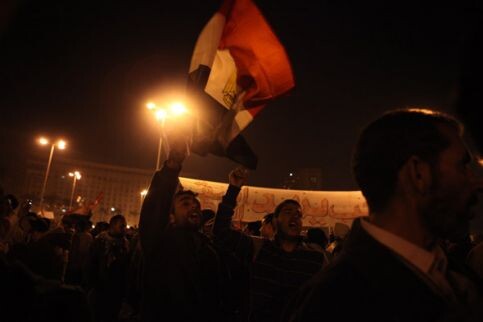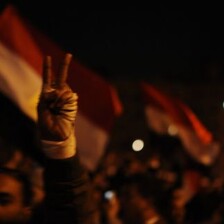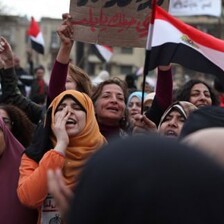The Electronic Intifada Cairo 2 February 2011

Protesters are holding their ground in Cairo’s Tahrir Square. (Matthew Cassel)
Yesterday I stood among more than a million people in Cairo. They came to Tahrir Square in the morning, some even came days ago and haven’t left since, and all day long they energetically called for the ouster of Egyptian President Hosni Mubarak. “Leave!” they cried. An effigy of Mubarak hung from a lamp post and someone carried a sign shaped like a donkey with the president’s face glued to the animal’s head.
In the evening, the millions who had been protesting across the country watched and listened to the 82-year-old Mubarak’s speech, hoping he would meet their demand. Instead, Mubarak took the path of Zine El Abidine Ben Ali, the deposed president of Tunisia, who at first tried to placate the protests that eventually ousted him by promising that he would not run for office again. Giving almost nothing, the unrepentant Mubarak accused protestors of causing violence and chaos, even threatening to punish them, and had not a word of comfort for the families of hundreds of protestors killed by state security forces since the massive protest movement began on 25 January.
Whether Mubarak is clueless about how things unfolded in Tunisia, or thinks he can write a different ending to the story, is anyone’s guess.
In downtown Cairo I photographed a group of men watching the speech. They sat outside a café in plastic chairs, as you usually see people watching televised football matches. But there were no water pipes or coffee tonight — the atmosphere was much more serious. As soon as Mubarak made it clear he would continue as president, the café patrons immediately stood up as one person lead chants against the president. “Mish ayzino!” — we dont want him — they cried, and marched off to Tahrir Square.
After last Friday’s violent clashes between protesters and police, the latter have been mostly absent from the streets of Cairo. After the police’s disappearance, looters took to the streets but were quickly stopped from causing major damage by civilian neighborhood volunteers. Many believe the removal of the police, followed by the arrival of looters, was orchestrated by the regime to create a feeling of chaos and insecurity so that Egyptians would feel that they need their dictator to provide them with security and stability.
Whether or not it was a ploy by the government, it did not work. The neighborhood watch groups have provedn extremely effective, and even to enter half a mile into any given neighborhood, one can expect to pass ten or so checkpoints guarded by men, young and old.
A similar volunteer security program has been established around Tahrir Square. After rumors emerged that protests might be infiltrated by Mubarak’s thugs, protesters began setting up unarmed human chains to check IDs and quickly search anyone entering the square.
When the spontaneous intifada or uprising in downtown Cairo broke out after Mubarak’s speech last night, several hundred protesters marched as quickly as they could to the square. The security volunteers grew nervous as they fast approached and tried their best to stop the oncoming mass of people. They locked arms with each other and formed a chain that stopped the angry crowd from entering the square straight away. Some of the protesters shouted at the volunteers for stopping them, and some shoving began. After emotions settled, the two “sides” were embracing each other. One protester even broke down in tears for fighting with his comrade.
Eventually people were allowed to enter, one by one, in an orderly manner, regrouping and joining the huge, vibrant crowd in the square. Chants broke out again, calling for Mubarak to go. The crowd was furious as they marched around the square, some carrying loudspeakers, some carrying drums, others removing their shoes and standing silently with them held toward the Mubarak effigy still hanging from the lamp post.
By that hour of the evening it was clear that many protesters were exhausted and had lost their voices from yelling so much, but they were very far from giving up. With signs, with shouts, with songs, with every means they have, the Egyptian people have spoken, and do not intend to go silent anytime soon. Thirty years of pent-up anger is being released in a spasm of protests across the country.
But Mubarak will not go down without a fight, it seems. As I write, hundreds of supposed Mubarak supporters are taking to the streets to challenge the protesters in Cairo and Alexandria. I’ve seen his “supporters” before. They’re notorious for coming out during protests and standing behind uniformed officers before they are eventually brought out to do the real dirty work — smashing the heads of protesters.
Hours after Mubarak’s speech, US President Barack Obama, who has stood staunchly behind Mubarak, addressed the world. Obama said it was not the role of the United States to choose the leaders of another country. However it is billions of dollars’ worth of US aid that has helped the dictatorship build the repressive state security apparatus that prevents the Egyptian people from exercising their self-determination.
It’s too late for the US government to play broker as it seems to be seeking to do. And it’s too late for Mubarak to maintain power. The struggle is in the hands of the people of Egypt, and the view from the streets of Cairo is that the struggle will go on.
Matthew Cassel is an independent journalist and photographer based in the Middle East..
Related Links





